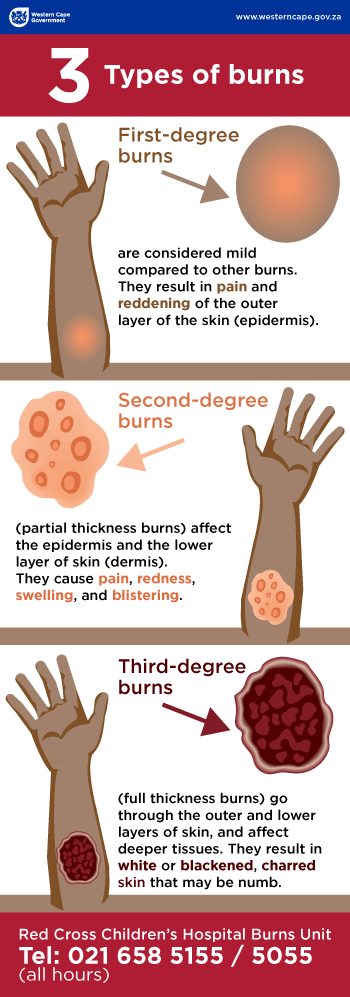National Burns Week 2016
South Africa observes National Burns Awareness week from 6 to 12 May to help raise awareness of the injuries suffered by burns and how to prevent it.
What are burns?
Burns are the third most common cause of accidental deaths amongst children under 14 years in South Africa. Burns are more than a burning sensation experienced with the injury and are usually associated with severe skin damage that causes the affected skin cells to die.
In most circumstances the burn victim can recover from burns without serious impact on their health but severe burn injuries can cause the death of the victim. The cause and degree of the burn will determine how serious the injury is expected to be.
Different burn levels
 |
Burns are categorised into 3 degrees which indicates the severity of damage to the skin. First-degree burns are the least severe with third-degree burns the most severe.
The different characteristics which define the different degrees of burns are as follows:
- First-degree burns: red, non-blistered skin.
- Second-degree burns: blisters and some thickening of the skin.
- Third-degree burns: widespread thickness with a white, leathery appearance.
There are also fourth-degree burns. This type of burn includes all of the symptoms of a third-degree burn and also extends beyond the skin into tendons and bones.
Burns can be caused by;
- hot or boiling liquids,
- chemicals,
- electricity,
- fires and flames, and
- excessive exposure to sun.
The degree of the burn is not based on the cause of it. Scalding, for example, can cause all three burns, depending on how hot the liquid is and how long it stays in contact with the skin.
Chemical and electrical burns require immediate medical attention because it can affect the inside of the body, even if skin damage appears to be minor.
First-degree burn
First-degree burns aren’t severe and cause minimal skin damage. They affect the outermost layer of skin and are also called “superficial burns”.
Second-degree burn
Second-degree burns are more severe and the damage will extend beyond the top layer of skin. This type of burn causes the skin to blister and become extremely red and sore.
Third-degree burn
Third-degree burns are the most severe and they cause the most damage, extending through every layer of skin.
Preventing burns
The best way to fight burns is to prevent them. Most burns happen at home and involve infants and young children who are the most vulnerable.
Applying the following safety tips can help prevent burn injuries before they happen:
- Ensure that kettles and their cords are always placed out of reach of children.
- Put all hot drinks, hot cooking oil and hot porridge out of reach of children.
- Do not carry urns or pots of boiling water around while there are toddlers on the floor or children running about.
- Turn pot handles away from the front of the stove.
- Put candles in a deep glass jar with sand at the bottom so that it kills the flame, should the jar be knocked over.
- Repair all faulty electrical plugs and leads.
- Report stolen cover plates on power poles or substations with broken fences or locks.
- Don’t leave children unsupervised near matches, candles, lighters or fireworks or when they’re in or near the kitchen.
- Lock paraffin and other flammables, including "safe" gels away.
- Don’t cover braai fires with sand. The heat stays in the sand for hours and will burn unsuspected feet walking over the sand. Pour water over fires and coals.
- Don’t cook eggs in a microwave. The shell can explode and cause severe face and eye injuries.
- Noodles cooked in microwave ovens become extremely hot, along with the container, and can cause severe burns.
- Pour cold water in the bath first and then add hot water. Set your geyser to low temperatures (about 55 degrees celcius). Always test the bath water with your elbow before bathing children.
- Avoid using tablecloths or anything a child can pull on and cause hot food or liquid to spill.
- Never hold a child while cooking.
- Test and stir all food before serving children to make sure it is cool enough to eat.
What to do in case of a burn
- Should anyone sustain a burn injury involving flames, the victim should stop, drop and roll to put out the flames.
- Don’t touch electrical injury victims before removed from the current – use a stick or non-conductor to avoid rescuer injury or death.
- The heat from a fire, hot water or electrical burn will continue to burn the tissue long after the offending contact is removed. It’s essential to stop the burning by keeping the burnt body part under cold running tap water for 20 minutes. Don’t use ice or ice water; it can cause frostbite because the skin is already damaged. The wound must be covered with clingwrap or a clean sheet and medical assistance sought.
- Cool a minor burn to help soothe the pain. Hold the burned area under cool (not cold) running water for 10 to 15 minutes or until the pain eases.
- Don’t apply butter or any oil-based product to a burn injury, the oil can trap the heat and make the burn deeper over time.
Burns can be very traumatic and victims who suffered more severe burns have to live with scars that might affect them for the rest of their lives. The Red Cross War Memorial Children’s Hospital encourages the public to help defeat the social stigma attached to children living with burns. Here is more information how to help those living with burns.


